The Battle Box Concept & Revolution in Mobile Warfare
12/14/2010
NO!
From Ground-Level
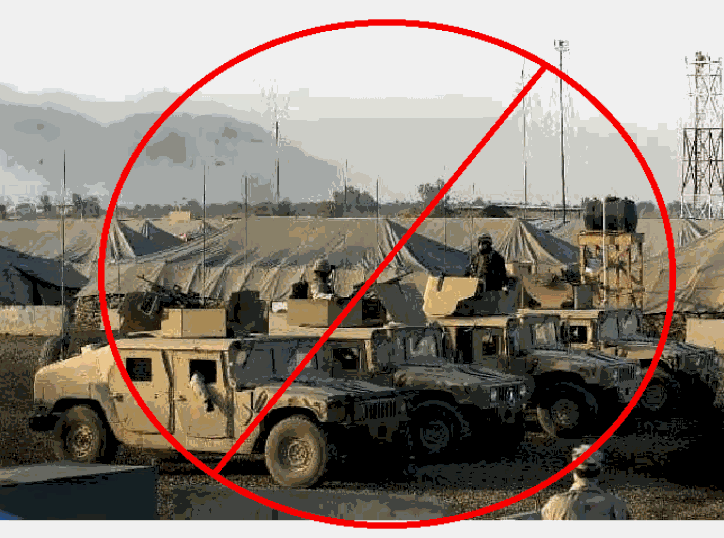
As Seen From Space
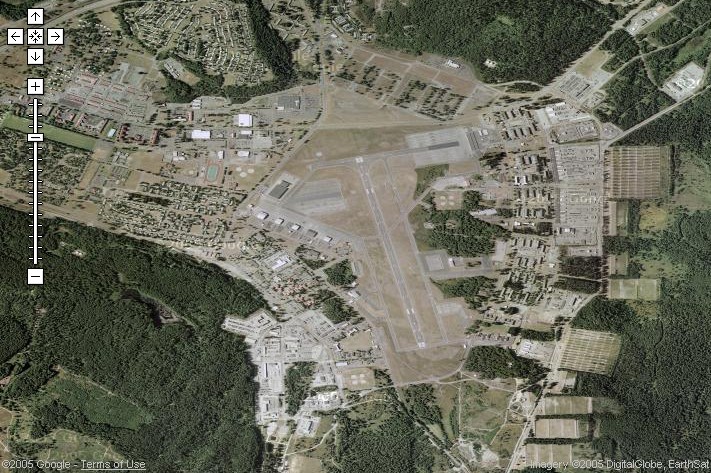
YES!
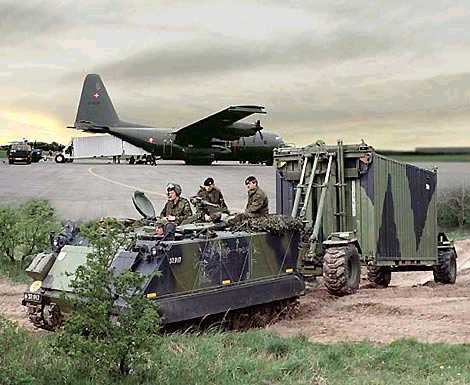
WE MUST DISPERSE AND CAMOUFLAGE AND BE READY FOR WAR NOW!
From Ground-Level

As Seen From Space

YES!

WE MUST DISPERSE AND CAMOUFLAGE AND BE READY FOR WAR NOW!
Table of Contents |
Author: Sam Damon Jr.
Email: transformationunderfire@yahoo.com Home Page: www.reocities.com/pentomicarmyagain |
Time for a 21st Century Military that THINKS, and is COMBAT-READY for non-linear, 4th Generation Wars
WE DO NOT ENDORSE PNAC.
WE DO NOT ENDORSE PNAC.
WE DO NOT ENDORSE PNAC.
Got it?
However, here's one small fragment of things those AmeroNazi assholes have said that is true:
http://thebiggestsecret.online.fr/american_emperialism/RebuildingAmericasDefen ses.pdf
"Shortages of manpower result in Soldiers, Sailors, Airmen and marines spending increased amounts of time on base maintenance-mowing grass, repairing roofs, 'painting rocks.' Most disappointing of all, military culture and the confidence of service members in their senior leaders is suffering. As several recent studies and surveys have demonstrated, civil-military relations in contemporary America are increasingly tense."
Cartoonist Chris Ashby offers some biting social commentary on how the U.S. military is baby-sitting Soldiers because of on-post barracks to do things like cleaning their rooms when we should be focused on warfighting.
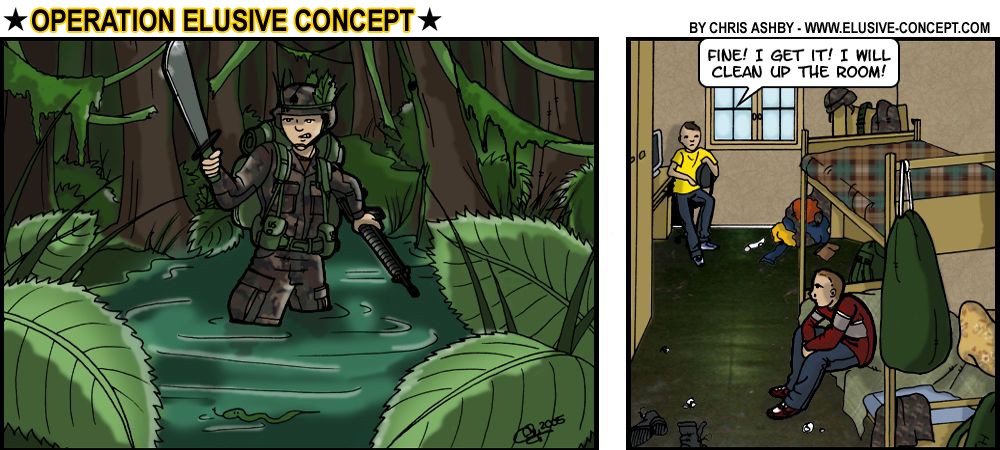
Its clear we must DISPERSE and get combat READY TODAY and not play around with buildings and lawn care and tents. The question arises;
Where did our Soldiers learn bad Slacker truck Habits?---Fort Lewis, Washington: "From Here to Eternity" Garrison U.S. Army Unready For War: As Seen From Space

James Jones, an Army combat veteran revealed the bankrupt and snobby Army culture as being unready for WW2 in his book; "From Here to Eternity". As Japanese planes are bombing and strafing U.S. Navy ships and Army/marine planes parked in neat rows to ward off "saboteurs" our entire force in the Pacific was nearly wiped out resulting in us almost losing the war on day 1. Despite the obvious need to drop the rank snobbery, work together and stop the non-tactical "parade ground" military, after WW2 we reverted right back to "From Here to Eternity" and suffered grievous losses in Korea, Vietnam, and now in Iraq. We are today, parking both ships, planes and trucks, troops, tanks and buildings in easily targeted rows, both in CONUS and overseas.
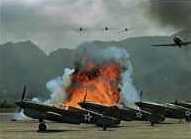
On the 21st century, non-linear battlefield dominated by high explosives we simply CANNOT afford to play BS barracks games and keep living in rows of buildings with our air, ground and sea platforms parked in rows, uncamouflaged.
If you have ANY doubt about the dangers we face of reliving "Pearl Harbor" which we compound by base closures compressing even more targets in smaller areas, look at the satellite imagery of U.S. bases using google maps.
1. GO TO
2. Type in
fort lewis wa
you will see a street map
3. Click on "Satellite"
Click on + to zoom all the way in on to see the clusterfucks of Stryker and other wheeled trucks
Move <--- and ---> to shift view from space to keep the wheeled truck narcissist wagons in view etc.
Here's the photo of Fort Lewis, Washington taken from space by a satellite with key features of the U.S. Army "garrison" BS mentality explained:
1. HUGE parade ground for brass to self-worship themselves with troop standing in hot sun for hours at a time. Troops have to waste hours mowing this huge lawn. Parade grounds and useless golf courses should be ripped out of every Army post and the space used for tank cross-country open terrain maneuver training or at the very least a firing range. You will notice there is no maneuver training area on Fort Lewis--they have to drive over 100 miles southeast to Yakima training center--more time and resources wasted, when we do not have the time or the money to waste. Is it a wonder our troops are so road-bound and easily blown up by roadside bombs in Iraq?
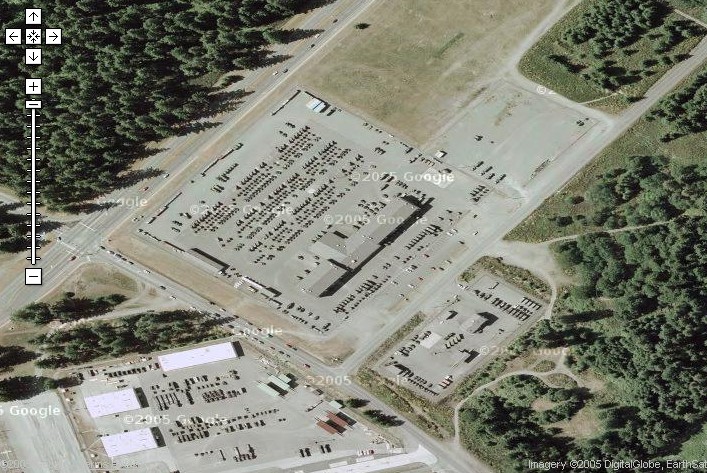
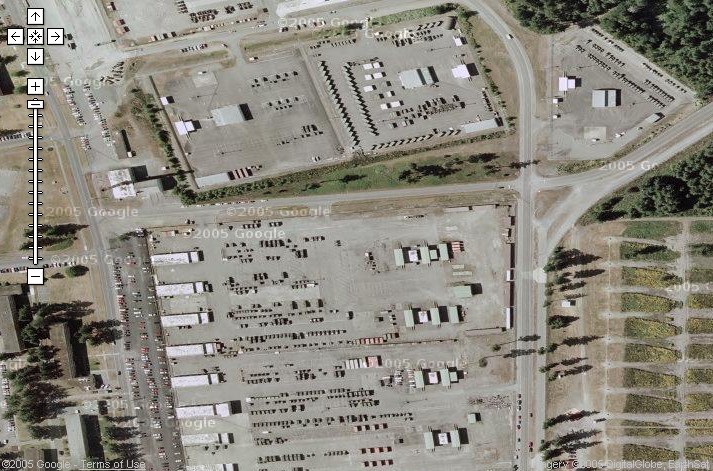
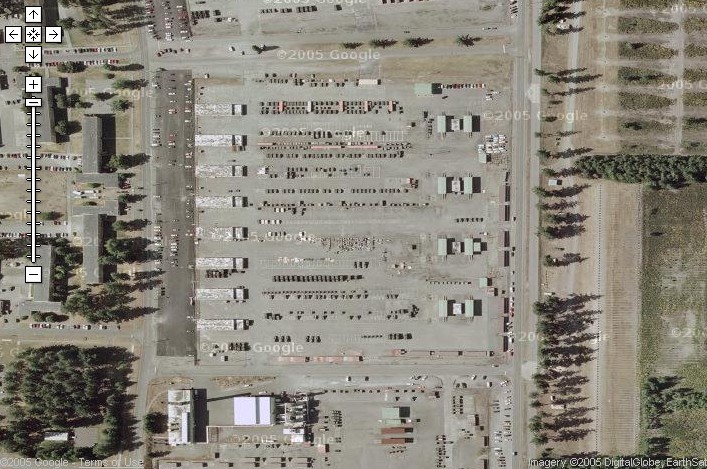
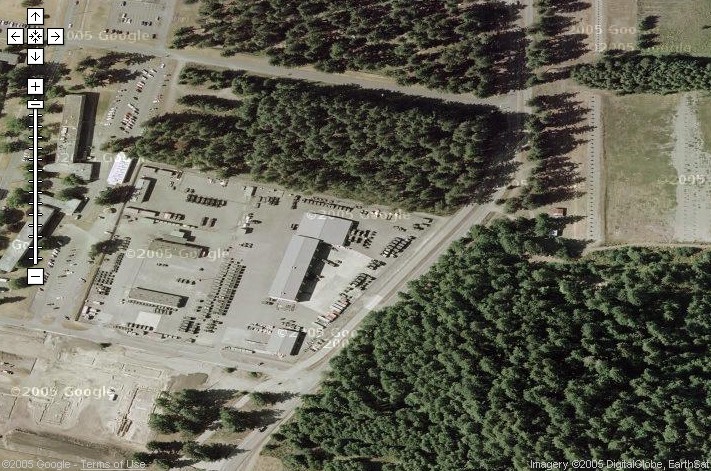
2. HUGE motor pools of Stryker, Humvee and FMTV vulnerable wheeled trucks in Fulda Gap Olive Drab Green paint that makes them clearly seen against gray pavement. Troops waste many hours obssessing over these flimsy and tactically unsound trucks under the hot sun to micro-manage and alleviate the anxieties of the brass and their bean counters that they will work. However, the hot sun and temperature elements are degrading the rubber tires, optics, paint constantly.
So as mother earth kills the life of these flimsy vehicles, they make an easy Pearl Harbor-esque target for enemies who could with GPS guidance destroy them en masse with just a few direct hits. ALL vehicles should be painted in universal TAN or BROWN and dispersed and co-located with their units in the field at all times under concealing vegetation and/or nets to keep the sun off, or better yet IN ISO containers. Some "war on terror" we are waging, huh? We didn't declare war on 9/12/01 and we are still not at war.
3. You will see 5 x CH-47D Chinook heavy lift helicopters and a UH-60 Blackhawk helicopter again in absurd "Fulda Gap" green camouflage paint making them easy targets on the ground and in the air. These aircraft should be GRAY for effective camouflage in the air and be covered in camou nets on the ground. The main runway of Gray Army airfield is only 6125 feet x 150 feet and the secondary runway is only 1867 feet by 46 feet. This is good enough to fly-away by USAF C-17s and C-130s, but the Stryker truck is too heavy to fly by C-130 even stripped down anywhere unless you want to go to Spokane, Washington. Only 3 Strykers can fit into a C-17 which we do not have many total, and only a squadron of 12 at nearby McCord AFB. If the Army were wise and transferred Stryker trucks to MP units where their road-bound fatal weaknesses would be offset by a less lethal mission and re-equipped with M113 Gavin and M8 Buford AGS light tanks, they could fly 4-5 at a time in C-17s and 1-at-a-time in C-130s to strategic distances (over 1, 000 miles). Moreover, if the main runway was lengthened to over 8, 000 feet, cargo 747s could fly brigade Gavin/Buford sets and all required personnel rapidly to any place in the world with international airports. This was what an Army that was serious about getting ready to fight anywhere in the world would do.
4. Here you see a feel-good sports field and 400 meter tracks for absurd sports PT in t-shirts, shorts and running shoes which has no combat relevance. Also notice the tennis courts. More evidence that the U.S. military garrison lifestyle is all about narcissism and not combat effectiveness.
5. Here you see the comfortable Rank Hath Its Priveliges (RHIP) officer's housing adjacent to the parade ground for narcissist ceremonies. This is disgusting and not leadership-by-example. These housing units should be torn down on all U.S. military posts/bases and everyone made to live off post in REAL civilian houses to have real civilian cultural lives instead of living in the cloistered artificial lifestyle that leads to snobby and disrespect of people with less money, rank and status--people like our foreign enemies and civil populace that we are trying to win to our side. Amerocentric snobbery does not win hearts & minds.
6. All over the post are multi-story troop barracks and enlisted family housing units where the underclass lives and the under 21 year olds can be frequently visited by their over-bearing "mother may, I?" chain of command to nitpick over the condition of interior paint and the state of the lawns around the buildings. So while America's enemies study how to kill us with the latest technologies, our troops spend their days picking up trash and mowing lawns in the hot sun or freezing cold after starting the day without enough sleep doing absurd sports PT to numb them down to better control them and remind them that they are somehow inferior to the careerist narcissists running the show who want to look good and get themselves promoted. Is it a wonder troops think 5-ton trucks weigh 5 tons? Is it a wonder they do not know what a RPG can or cannot do? Is it a wonder our troops are ignorant of warfare and think they can ride around in wheeled trucks and just shoot the enemy as if it were a TV western gun duel? The sad truth is they enter the combat zone sleep-deprived for months and years at a time and are falling asleep at the wheel and dying. They are getting blown up by a push of a button by roadside bombs before they can even get a chance to shoot their hand weapons. War is not an event to prove manhood and adulthood you should already have, its not a game or a duel. Its about winning or losing, living or dying. And we cannot afford any longer to waste time on 19th century parade ground BULLSHIT on today's lethal, non-linear, 4th generation warfare battlefields dominated by not just bullets but high explosive weaponry.
Let's be brutally honest, shall we?
Where is the constructive effort to be good at warfighting?
U.S. military is not "AMATEUR hour"; amateur implies at least we are TRYING; we are not trying; U.S. military is PHONY.
Air Force & Navy when they fly aircraft and sail ships are kept somewhat honest and combat capable because if they at any second fail they can be dead falling from the sky or in the water where man really doesn't live. To warfight they need to actively operate air/sea platforms.
In contrast in land combat, man lives on land; he does not need a platform to exist on land that automatically has a war function. He is under no compulsion to be combat ready even by platform default. Man can die on land from EXPOSURE however, and since he lives on land all the time for a peaceful, civilian life his answer to this is FIXED BUILDING SHELTER. Since man has a civilian existence means that has no military platform utility, both the Army and marines have been corrupted by building and lawn care as convenient excuses/time wasters by people who are phonies who do not want to be combat ready, they want to be phony narcissist snobs and extended adolescents paid middle-class wages.
Actives: wake up each morning sleep-deprived, roll call troop formation, do non-sense sports PT, then breakfast, some more troop formations, "leaders" meetings, paperwork, Mondays wasted in motor pool doing PMCS on tactically unsound Humvee SUV trucks, Tuesday/Wednesdays building and lawn care, Thursday meetings, Friday paperwork. WHERE IS THE TIME TO DO ACTIVE WARFIGHTING EXCELLENCE? The entire daily and weekly routine established by the narcissist egomaniacs to baby sit the economic weak co-dependants is geared around BULLSHIT (lawn and building care) not active thinking cat vs. mouse warfighting.
www.combatreform.org/sleeplessarmy.htm
Reserves: one weekend a month they arrive and waste Saturday and Sunday with roll call formation, sports PT then lunch, then yadda yadda meetings, then time to go home for the day. Two weeks in summer is fun time away from wife and kids.
Solutions
1. Get rid of static buildings: force ground troops to every day do combat things by making them live every day in tactically-sound, portable, fortifiable "Battle Boxes" THERE IS NO GARRISON. There is only the FIELD.
www.reocities.com/strategicmaneuver/battleboxconcept.htm
www.reocities.com/strategicmaneuver/battleboxes.htm
2. Make Reserves go to war for 24 hours each month
www.reocities.com/paratroop2000/realreadyreserve.htm
3. Get rid of phony narcissists and economic bennie boomers and replace with warfighter enthusiasts
www.reocities.com/paratroop2000/weakcodependantarmy.htm
4. Cat & Mouse Warfighting Experimentation Needed
www.combatreform.org/cluelessarmy.htm
Once we cut out all the BULLSHIT we will face the tools we have in front of us and start grappling with how we will use them in war and how to better use them by ACTIVE THOUGHT. Force everyone to FACE THE TOOLS THEY HAVE IN FRONT OF THEM their minds will be forced to THINK about what it is they have. FORCE THEM TO BE IN A WAR SETTING AND THEIR MINDS WILL PONDER hey, what if I left on foot over there to patrol and an enemy sapper team is already there?
The same intellectual development and innovation that I undertake will happen with the troops, what we call FIELD CRAFT. How can you have FIELDcraft when you are NOT IN THE FIELD but in garrison doing LAWN CARE?
A few examples:
Drive vehicles and lay smoke screens with OPFOR to perfect what it takes to evade optical weapons engagement
Off-road, x-country driving of TRACKED armored fighting vehicles to avoid roadside bombs/RPG ambushes
Finding out how to hide vehicles from thermal imagery
Shoot actual soft nose RPGs at vehicles and practice evading them
Actual hardening of combat vehicles and loading arragements perfected not static BS "this is the SOP we've always used so go back to sleep"
Therefore, if we want a military ready to go to war, we cannot anymore waste time on buildings and lawn care. We are already at the "crazy" point where absurd 19th century practices are causing fatalities. Half the Army and most marines think all you need to win wars is a rifle in your hand and a ruck on your back so why not waste most of your time on lawn care and other building BS? These are the light narcissists getting themselves and others blown up in Iraq.
There simply is not enough time for both a "garrison" and a combat "field" army in the 21st century. Something has to give and go bye bye.
We all know right now that good people are avoiding our ground forces and cat IVs are filling the ranks as cannon fodder for the open ended Iraq occupation. Nobody with aduly sensibilities and other life options than military service wants to die in a truck in Iraq. These adults are "voting with their feet".
So we have made the choice for garrison with disastrous results. We need to unchoose garrison.
When I was recently on active duty in XVIII Airborne Corps: all we did was lawn care.
Please read our daily schedule:
www.combatreform.org/sleeplessarmy.htm
www.combatreform.org/cluelessarmy.htm
Recap:
Monday: motor pool
Tuesday: lawn care 1
Wednesday: lawn care 2
Thursday: Sergeant's time
Friday: pay day activities or "meetings"
When you have permanent buildings, lawns, you end up with narcissists who think all you need is sports PT and somehow you are ready to fight with a ruck/rifle-- you have the present disaster in Iraq. The non-linear battlefield (NLB) is dominated by High Explosives and to counter them you need maneuver forces that employ TRACKED ARMORED FIGHTING VEHICLES ie; "tanks". A simplistic, lazy, bonehead "rifle & ruck" sometimes from a wheeled truck mentality does not cut it. The DAILY GARRISON ROUTINE of BS centered on buildings/lawn care leaves no time to be combat trained. And I did say NO TIME; during the almost year we were on active duty assigned to XVIII Airborne Corps we did not go to the field, at all, period. Troops went straight from garrison BS to Iraq, some to their deaths.
What is so important about fixed buildings?
Again, read our proposal here:
www.reocities.com/militaryincompetence/battleboxconcept.htm
Report to duty EVERY DAY to your BattleBoxes in the field (see PPT slide show). End of day you go home, off post to a real civilian life for a few hours.
The modern non-linear battlefield requires work EVERY DAY not the current garrison set up when we spend the entire day on BS rank & ego games.
19th century spit and polish was deliberate time wasters to keep troops in line during a simpler era of warfare. We cannot afford this today. Time is the one thing that is "zero sum" and its high time we cut out ALL of the BS we waste our precious time on.
Aha!
Before some of you invoke the heroic "leadership" that overcomes the parameters option. Been there, done that, got the t-shirt.
Of course I kicked ass and personally led my men to have all our lawn/building care duties done on the monday of motor "stables" by myself personally pitching in as an officer and not taking breakfast/lunch.
Then...
Tuesday-Friday everyone above me knew we had our time to train and we would no longer be mediocre like them so "suddenly" battalion needed a work detail. "Suddenly" brigade needed 5 Soldiers.
Before long, there was no more unit training.
All my men got for doing their garrison work better and more efficiently was MORE GARRISON BS WORK and less combat training.
Yes, we have bad people in charge etc. etc.
Well, guess what?
We ain't going to be firing them any time soon.
So I say let's NOT GIVE THEM AN OPPORTUNITY TO DO GARRISON BS---NO MORE BUILDINGS AND NO MORE LAWNS!
Make everyone report to duty every day in an unimproved field with BattleBoxes and force them to be Soldiers and not phonies. As long as we provide them a "garrison" they have the excuses they need to be spit 'n polish frauds.
Pretty radical?
Yes.
But if we do not do this and do this soon, you can kiss this country goodbye. We already have a major melt down in recruiting and retention due to our troops-in-trucks incompetence in Iraq.
Again,
something has TO GIVE.
We cannot keep old systems of thought and methods in place and slap on some high tech and hope to get by. WE HAVE TO CHANGE for real to prevail against THINKING enemies on the NLB.
The reason why we want to "pull the rug out" from the garrison lifestyle is to force lazy human nature to drop the snobbery that comes from spit n polish and work together within BattleBoxes that force them to be in the field. To use street jargon, "be real".
Other things we need to do culturally in our military would be to stop winking at and encouraging snobbery and narcissism via an IDF style ethos:
www.combatreform.org/usarmyethos.htm
But we must TANGIBLY "Drain the pond" where narcissism breeds: which is our buildings and lawns on military posts/bases!
The following account of the desperation "immersion" training for Iraq shows that we need to be "immersed" in combat ALL THE TIME WITH BATTLE BOXES. Once we cut out all the BS we will have money to train. One year's worth of money not spent on bogus buildings on civilianized military bases could pay to CONTAINERIZE THE ENTIRE U.S, MILITARY SO IT CAN ACTUALLY FIGHT WARS AND DEFEND AMERICA, ONE-TIME, FOREVER. Notice in the immersion training story that things that are allegedly "cheap and affordable" like disposible AT4 rockets are never available to fire in our phony, garrison building-centric military. We need to get RPGs that we can get rockets/booster charges for to shoot. If necessary we should take our own money and buy training ammo from KMART or mail order; 1,000 rounds of 5.56mm runs for about $100 last I checked.
Here is a report from an officer in Iraq about how our phony Military-Industrial-Congressional-Complex (MICC) is always eager to spend money on BS BUILDINGS that make the brass feel like CEOs but not on weapons, ammunition and armor for our troops to be successful and survive COMBAT:
"Widespread disgust in the field with for example the 17 million dollar dining facility built inside the enormous base where the 1st Cav Division Headquarters was located and where now the 3rd ID Division Headquarters is located. Resentment in the field where armored protection is still missing and grenades are hard to come by because luxurious facilities are constructed for senior officers and their staffs is very strong. Intell and useful support from Baghdad Headquarters is nonexistent. All the useful intell is collected by the army and marine units in the field fighting the insurgents. While the Sunni population is in some parts of the country weary of the conflict, most still bitterly resent us. So-called Iraqi Army is 98+% Shiite Arab with Kurdish units from the north augmenting. Sunnis are isolated, bitter and resentful. Generals are still focused on garrisoning Iraq and controlling territory, not killing the enemy. Marines with forward-basing concept borrowed from the British Army are having success in the areas south of Baghdad between the Euphrates and the Tigris, but marines are taking heavy casualties because they lack armor, firepower and mobility (no tanks and brads). Border with Syria is wide open. Stryker Brigade runs around and arrests people, running police type raids outside of Mosul, but has done nothing to change the status quo along the border. Finally, perception is that the commanding generals are collectively out of touch with what is really happening on the ground. Senior leadership is still reactive - no offensive strategy."
Winslow Wheeler's article in Naval Institute Proceedings on non-warfighting "pork": Bad Congressional pork: Stryker/Humvee trucks, building construction
www.usni.org/proceedings/Articles04/PRO10wheeler.htm
Home > Proceedings Magazine > 2004 > October Issue
CommentaryCongress's Deeds Do Not Match Its Words
By Winslow T. Wheeler
Proceedings, October 2004
Some observers regard the 9/11 Commission's findings and recommendations as holy writ. Whether they are or are not, congressional reaction to the commission deserves minute scrutiny. Actions speak louder than words.
On Capitol Hill, where I worked for more than 30 years, the most meaningful deeds are the changes legislators put in bills. Senate actions on the defense budget in May and June 2004 say a lot-but not what the senators want you to know. Amendments they added to the National Defense Authorization Act for fiscal year (FY) 2005 reveal distorted priorities. On 23 June, 97 Senators voted for the bill; none were opposed.
The rhetoric used on the floor of the Senate matched that in the Armed Services Committee's published report to explain the bill. All wanted only to "provide our men and women in uniform with the resources, training, technology, equipment, and authorities they require to combat terrorism and win the global war on terrorism, with particular focus on supporting the conduct of military operations in Iraq and Afghanistan."1
As written, the bill added $1.2 billion for such items as new helicopters, Stryker armored vehicles, body armor, winter clothing, and armored high mobility multipurpose wheeled vehicles. Hidden countervailing measures, however, started in the bill's operation and maintenance accounts, which fund training, spare parts, gas, food, transport, and other essentials. The committee quietly cut Army depot weapons maintenance by $100 million and removed $1.6 billion from all the services' "working capital funds" for transportation and consumables (for example, helicopter rotor blades, fuel, food, and much more). The committee also cut pay for activated civilian technicians by $532 million and reduced other military personnel costs by $276 million. The committee cut another $1.67 billion in anticipation of lower inflation in 2005-despite the Federal Reserve Bank's prognostication that falling interest and inflation rates essentially are a thing of the past. Senator Daniel Akaka (D-HI) took written exception to some of this, but he was ignored (and did not follow through in any case). Much of the $4.2 billion cut was reinserted in the form of military construction projects, an executive aircraft, and hundreds of small procurement and research additions that individual members wanted.
When the full Senate took up the bill, 154 successful amendments fixed no major problems and some even made things worse. Seven amendments simply corrected minor technical errors; 28 amendments-such as Senator Jack Reed's (D-RI) on service academy athletic programs-were irrelevant to major defense issues. Another 30 amendments-such as that of Senators Trent Lott (R-MS) and Thad Cochran (R-MS) to reduce military pay by $3 million to develop a Navy antenna in Jackson, Mississippi-traded pay raises and other funding for pork.
Meanwhile, the Senate increased personnel benefits for selected constituencies with 27 amendments. Senator Kay Bailey Hutchison (R-TX) facilitated disability payments for military academy cadets; Senators Mary Landrieu (D-LA) and Olympia Snowe (R-ME) increased benefits for the survivors of military retirees. Merits notwithstanding, the eight more expensive of these amendments added $1.2 billion in FY 2005 and $8.4 billion over the next five years, which did nothing to undo the $4.2 billion shortchanging of key warfighting accounts.2
Another 42 amendments concerned peacetime defense issues: 25 on contracting issues and 17 on ballistic missile defense and nuclear weapons issues. Finally, 35 amendments applied to the war on terrorism, including reimbursement of soldiers for military equipment they had bought themselves and clarification of Army Judge Advocate General's authority in the Abu Ghraib prison scandal. Although these and a few other amendments were constructive, they were of secondary importance.
On 2 June, the Senate added $25 billion for combat in Iraq and Afghanistan, but only for FY 2005. War funding at the end of FY 2004 was $10 billion short according to some analysts. The amendment provided less than half of the $55 billion the Congressional Budget Office estimated to be the most likely cost of Iraq and Afghanistan for FY 2005. Thus, even as they pertain to the war on terror, the actions were inadequate to current and future needs.
And the foregoing is the good news. Closed-door Senate-House of Representative meetings were under way in August and September to resolve differences in the House and Senate versions of the bills. Historically, this is the stage where the worst ideas are hatched.
President James Madison opined that all politicians should be viewed as wolves in sheep's clothing. Indeed, they must be watched closely, which applies equally to intelligence reform. In that case, pork and irrelevancies will not dominate the agenda-regrettably, however, form is likely to take precedence over substance.
National Defense Authorization Act for Fiscal Year 2005, Report [to accompany S. 2400], Committee on Armed Services, U. S. Senate, Senate Report 108-260, p. 3. back to commentary
Author's tabulation of the costs of eight amendments from tables 3, 4, and 5 presented in Congressional Budget Office Cost Estimate, July 21, 2004, S. 2400, Ronald W. Reagan National Defense Authorization Act for Fiscal Year 2005, as passed by the Senate on 23 June 2004, pp. 7, 13, 17. back to commentary Mr. Wheeler is a visiting senior fellow at the Center for Defense Information. His new book, The Wastrels of Defense: How Congress Sabotages U.S. Security, is avaliable from the Naval Institute Press.
From Colonel David Hackworth's SFTT.ORG:
F Company, 425th Infantry, Long Range Surveillance, Michigan Army National Guard, are heroes. But in Iraq, they call themselves "The Kings of the Damned."
How they fell from glory is a stain on the proud history of the U.S. Army and clearly reflects the Pentagon's inability to meet its mission goals in Iraq with a force largely constituted of Reservists and National Guardsmen who found themselves under-trained, under-equipped, and unprepared for the rigors of battling the Iraqi insurgents.
What is especially shocking is that F Company has long been an elite, airborne-trained, three-time volunteer fighting force, one of only a handful of airborne-qualified units in the Army National Guard. Its roster includes lawyers, physicists, police officers, fireman, and in fact the entire gamut of professions shared by the best and brightest of America's sons who enlisted as part-time Soldiers in case their country called. Just two years and three months after 9/11, they responded to the summons.
On Dec. 10, 2003, amidst a flag-bedecked ceremony filled with patriotic fervor, more than 300 families from all over Michigan gathered to send their sons, brothers and fathers in harm's way. Maj. Gen. Thomas G. Cutler, adjutant general of the Michigan National Guard, told the men their mission was one they had trained long and hard to be ready for despite their knowledge it would be a long and difficult struggle: "You hope there isn't a fire but you have trained hard and you're eager to fight it," Cutler told the assembled men and their families. He then presented the unit with a Michigan National Guard flag to be flown in Iraq.
The next morning, filled with the curious combination of anticipation and trepidation that for centuries has marked the warrior's entrance into war, F Company arrived at Fort Bliss, Tex., to begin a two-month period of intense training the Army claims is designed to prepare the deploying Soldiers for the rigors of combat.
"We were very motivated and eager to venture forth into the unknown and test that which we were made of. For years we trained in our specialized tasks of reconnaissance and surveillance," one senior enlisted Soldier wrote in a detailed but unofficial After Action Report (AAR) obtained by DefenseWatch (click here for the AAR Text). "We used the Army template of the 72-hour isolation and planning and the 48- to 96-hour long mission's cycle. The men of the 425th could execute this type of mission in their sleep and had executed this type of training on average of three times a year for the last eight years," added the NCO, who asked that his name not be used.
The Army calls the training offered deploying Soldiers like those in F Company "Theater Immersion Training." It has become the watchword of the Army generals charged with preparing America's part-time Citizen-Soldiers for their fulltime role as warfighters is Iraq and Afghanistan. Last fall, Lt. Gen. Russell L. Honoré, Commanding General of First U.S. Army, shared his vision with other leaders at the First U.S. Army Commander's Conference in Atlanta.
"When Soldiers get off the bus at the MOB (mobilization) station, they must feel they have arrived in Iraq or Afghanistan," Honoré told the assembled officers.
To do that the Army has created at Fort Bliss and other stateside bases a mock Iraqi village and compound similar to what Vietnam-bound neophyte infantryman discovered when they passed under a giant Combat Infantryman's Badge at the portals of Fort Polk, La., three decades ago. The badge and the sign beneath it marked the way to "Tigerland," the home of the Vietnamese village that weary trainees would get to know better than their girlfriends back home.
"Instead of living in a normal garrison environment, Soldiers will see concertina wire, entry control points, and guard towers to simulate the Forward Operating Base (FOB) environment," Honoré explained in Atlanta. "In an FOB, small-unit leaders not only train on theater-specific tasks, [but] they have an opportunity to exercise their troop-leading procedures and basic discipline on a continuous basis."
[1st TSG (A) EDITOR: basically a "reform school" for a military that has been goofing off for years in garrison.]
Unfortunately, according to a number of F Company Soldiers, they found instead what one later described as a "circus of stupidity" at the Texas base. If the troops of are to be believed, they were immersed in a bureaucratic tangle of ill-prepared quarters, non-existent training situations, very little practice ammunition, no hand grenades, limited range time, broken trucks and equipment, and cast-off weapons they rarely if ever had the chance to fire.
Their training, documented in detail over the months that followed, was the antithesis of the vision offered by Lt. Gen. Honoré. Col. Al Jones, First U.S. Army's Deputy Chief of Staff for Operations described it thusly:
"Theater Immersion is a dynamic training approach that gives us greater flexibility to train Soldiers. With theater immersion we can create more events, longer events, ramp up the volume or turn it down based on the training needs of Soldiers and units. Our goal is that Soldiers respond to threats intuitively, regardless of the situation in which they might find themselves."
"We have a non-negotiable contract with the American people to prepare her sons and daughters for war," Honoré added. "We must use imagination and innovation to do this better than we ever have before. We cannot, we will not fail in this task."
[1st TSG (A) EDITOR: then get rid of "Garrison" BS forever. Employ "Battle Boxes" and troops will be "immersed" in war every moment they are on duty BEFORE we have a war.]
This is how one grizzled sergeant from F Company, a former U.S. Army Ranger and Special Forces-qualified Soldier, described his unit's subsequent training experience at Fort Bliss: "Bullshit."
F Company trained at what used to be known as McGregor Range, an empty, hostile area of scrub and sand the men who trained there said replicates Iraq quite well. In other times and wars, McGregor was used to train basic trainees in marksmanship and anti-aircraft specialists in the art of shooting down warplanes.
A spokesman for the 91st Division (Troop Support), the California Army Reserve unit charged with training F Company, described McGregor as a "recreated Iraq." He added, "They have built six or eight buildings to represent an Iraqi village where the troops do cordon and search exercises. The buildings have no roofs so that the observers/controllers can stay on catwalks and observe the exercise. They have shoot houses with six-inch thick walls to fire in."
One 91st Division official, who said he was not authorized to give his name, said the Fort Bliss exercise areas are very useful in preparing Soldiers for what they will encounter when they arrive in Iraq. In a later communication the spokesman reported that the 91st's deputy chief of staff indicated that the California-based training support command would not be able to officially respond to the allegations contained in the AAR.
"It seems that there is a congressional investigation underway, and the division does not want to stir the pot unnecessarily. That said, I can tell you that F [Company] received good training that was approved at FORSCOM level. They received nearly a half a million dollars worth of new gear prior to departure."
Jean Offut, a spokeswoman for Fort Bliss, said the 91st Division and other reserve units have done an outstanding job training more than 50,000 Soldiers preparing for deployment in Iraq and Afghanistan. She said civilian employees and military technicians and engineers spent $400,000 preparing F Company's equipment and weapons for deployment overseas. "Ninety to 100 percent of their equipment was certified [for combat deployment]," she reported.
[1st TSG (A) EDITOR: $400K would buy 4,000,000 rounds of 5.56mm ammunition to train on]
Not so, a senior F Company NCO noted in his unofficial AAR.
"Our experience here at McGregor has been one of absolute agony by way of `bullshit.' The personnel here cannot be trusted to plan a square dance. This generalization applies to the highest command of this fiasco called a `MOB.' The Soldiers of the 425th are only prepared for their deployment for operations in harm's way because of their own efforts. Very little credit can be given to the MOB site except for issues pertaining to supply and maintenance."
If that assessment weren't scathing enough, several members of F Company described their training experiences at McGregor as "fruitless, worthless, useless, and a waste of time that only benefited the cadre who seemed to enjoy inflicting chickenshit nonsense on us to pass the time of day." Those comments represent some of the more constructive criticisms offered by the men of F Company.
The detailed, 22-page AAR sent to Pentagon planners by members of F Company describes the Michigan Soldiers' training experience in grisly detail, covering everything from the MOB to the poor quality of the barracks, mess halls, medical care, training facilities, equipment, gymnasium and transportation. In addition, the AAR describes the condition of the weapons provided, the amount of ammunition F Company Soldiers expended in training, and the quality of the instruction provided by the reservists of the 91st Division, a non-combat training command filled with inexperienced reservists called up to train the war fighters for missions they themselves had never performed using weapons and tactics they had never used. The kindest thing said of them in the report is that they showed up for work most of the time.
One paragraph about the availability of training ammunition described in the AAR sums up the frustrating situation in which F Company found itself:
"Ammo for training is key when training for combat."
"We are not a CS (combat support) or a CSS (combat services support) unit: We are Infantry - `we fight.' I cannot put it any simpler than that. While here, we fired 24 rounds to zero and 40 rounds to qualify. We were then given 120 rounds of blank ammo for the entire SASO training block. Who in their right mind signed off on this?
"We have been called away from our homes and families for hostile operations. We are owed a chance to be trained properly and given the tools to obtain that objective. I, and all the Soldiers resent the fact that we are just `checking the blocks' to be moved into theater. As an 11B [infantry MOS] we are suppose to fire the AT-4, use a claymore mine, throw hand grenades, fire the [M]203 grenade launcher, fire our crew-served weapons, fire the Mk-19 grenade launcher, fire a .50 cal machine gun; almost none of which has taken place. While in theater we will be expected to execute any number of tasks, most will involve infantry duties and accomplishing the bare minimum is not an option when my Soldiers are in the game. May God have mercy on your souls, you miserable wretches."
In response to a DefenseWatch request for comment on the AAR by F Company commander Maj. Thomas Woodward, senior MIARNG officials provided this written statement from Col. James R. Anderson, assistant adjutant general, which stated in part:
"Soldiers are encouraged to voice their opinions and concerns. Based upon the concerns of our Soldiers, issues have been discovered and addressed. The Chief of National Guard Bureau and other General Officers have visited the training site at Fort Bliss. After seeing the site, talking to Soldiers and observing training, they were assured the Soldiers are being prepared to successfully complete their missions in theater."
[1st TSG (A) EDITOR: unless THE SOLDIERS THEMSELVES ARE SATISFIED the problem is not solved. In fact, even then we cannot assume they are combat ready since they are not the final authorities on combat readiness. But they certainly are more on the ball than those not going to Iraq.]
This is one Company F Soldier's response from Iraq: "The final point [is] that the part-time Soldier comes at his countries calling at a moments notice. [He] gives up his civilian life, leaves his family and more then likely will lose his job to come here. Some have left life and limb in this accursed place. Then to add insult to injury, he is given next to no training, poor equipment and expected to execute a mission as well as the active component. If he falls short he can expect to be court-martialed or face lesser forms of military justice. The officers in charge can rest easy because the enlisted part timers will take the fall."
National Guard warriors of F Company, 425th Infantry sweated out so-called "Immersion Training" at Fort Bliss, Tex. for several months beginning in late December 2003, they griped and groused and wished they were already in Iraq, away from the seemingly pointless training chickenshit in which they were being buried alive.
Instead of weapons training, small unit tactics, weapons familiarization activities and live-fire exercises, they found themselves attending lecture classes. Rather than shooting hundreds of rounds of live ammunition, they were limited to zeroing in their personal weapons with a mere 24 rounds, qualifying with 40 rounds, and firing all of 120 blanks wearing MILES gear while pretending they were on a search-and-cordon operation in Iraq. The M-60 [medium] machine gunners were issued 200 rounds for live fire and in squad training the troopers fired 100 rounds of M-16 ammunition. F Company spent the rest of its 10 weeks getting shots, physicals, filling out paperwork, listening to excuses, performing first-echelon maintenance and otherwise uselessly spinning its wheels - or at least trying to get them to spin - as one F Company Soldier observed.
Meanwhile, the Army trainers at Fort Bliss, reservists from the 91st Division (Troop Support) based in northern California, tried to prepare the men for what they would encounter in Iraq. The training is based on the Army's model of what Soldiers who find themselves in Iraq can do to protect themselves from insurgents who excel in attacking convoys and security teams lashed together from transportation units and other support personnel unfamiliar with the finer points of close combat. The trainers themselves were admittedly unfamiliar with the scenarios they were required to present and even less qualified in infantry tactics and doctrine that F Company's 140 troopers - one of only a handful of Airborne units in the Army National Guard - have long excelled in.
"There are many instances of a tasks being taught one way at one station and that same task is being enforced in a completely different manner at another station." a senior F Company NCO wrote in an unofficial After Action Report (AAR) on his unit's experiences at Fort Bliss and later in Iraq. Here's how training inconsistencies cropped up at Fort Bliss:
"For example, we just completed the squad live-fire exercise, we were taught how to bound and move in squad and team size elements. The day after we completed the squad live fire, we moved on to the vehicle live-fire range, where they are enforcing a completely different standard on how to move under fire. Vehicle live fire focuses on individual movement as a squad, while the squad live fire focuses on moving and bounding in fire teams .... On the other hand, the CS and CSS units that have never done this are becoming confused on which technique is to be used. The stations should coordinate on how the Soldiers are being taught and enforce the same standard across the board. This will help cement the tasks into the minds of the Soldiers; a basic case of the right hand not knowing what the left hand is doing!"
Last week, a 91st Division spokesman described F Company as a "good unit" that was subjected to the same training and experiences as all the other activated National Guard and reserve components passing through Fort Bliss. The spokesman, who asked not to be identified, told DefenseWatch F Company one time demonstrated its zeal by voluntarily clearing away brush from the firing ranges by hand so it could practice firing live rounds.
Despite that glowing anecdote, there was unfortunately, very little training ammunition to be had. The men were never able to fire any AT-4 anti-tank rounds despite the fact the M136 AT-4 is the Army's primary light anti-tank weapon. Nor did F Company shoot its Mk-19 grenade launchers or throw any hand grenades, not even dummies, F Company troopers reported.
But F Company did receive a heavy dose of regular Army discipline. The strict discipline Michigan's elite sky troopers were subjected to at Fort Bliss' McGregor Range training area was necessary to "put their heads back in the game," a second 91st Division spokesman said. The "game" apparently included breaking down the Citizen-Soldiers' independent streak, exemplified by their desire to go to the latrine without supervision.
It seems a corrective action was considered necessary to keep Soldiers being trained from wandering off during duty hours. That led to an order that mandated that Soldiers wishing to use the latrine had to turn over their ID cards before doing their business, one F Company Soldier reported. The order included senior non-commissioned officers as well as junior enlisted men, a situation that enraged F Company's experienced troopers more than perhaps any other situation they encountered at Fort Bliss.
"The [ID card] action took the cake," the Soldier told his superiors in a confidential correspondence obtained by DefenseWatch. "We of the 425th can go into harm's way; most of us have 15 years or more years in the military system and we have to turn in our ID card to use the toilet. Who is the numbskull who cooked that up? It sounds to me like something a West Pointer would do. I would like to thank whoever came up with this from the bottom of my heart for destroying our last spark of morale, and humiliating us one last time, before we depart your festering stinkhole."
Unfortunately, leaving Fort Bliss was not as easy as jumping in their newly assigned vehicles and driving away to their embarkation station with their carefully prepared weapons. The equipment they were issued was rife with problems, particularly among crew-served weapons, vehicles and communications gear, according to the F Company AAR obtained by DefenseWatch. Upon receiving their weapons, several F Company NCOs with operational experience in Grenada, Panama, Afghanistan and Iraq in airborne infantry units inspected the weapons for functionality. What they discovered was a laundry list of appallingly dangerous problems for an infantry company preparing to encounter close-quarters combat.
Out of 21 M-60 [medium] machine guns receipted to F Company, 13 were either below minimum standards or completely inoperable, the AAR said. Only three of the essential weapons were completely functional. And this was after the weapons had been returned from repairs at the Fort Bliss support facility known as the "CUBE." Some of the problems included broken firing pins, worn ejectors, cracked barrels, weak operating rod springs, broken locking lugs and a host of lesser evils. Several M-9 pistols and 20 of the unit's M-203 grenade launchers also had deficiencies after being repaired. F Company's armorer was able to fix most of the deficiencies with scrounged parts and experience, but several of the crew-served weapons were shipped still broken, the AAR added.
One senior F Company NCO said that the "weapons were turned in with 2404 and 2407 forms [repair/maintenance request forms] completely and correctly filled out. These noted all deficiencies and all weapons were returned untouched with the exception of one or two weapons."
Ditto for F Company's five-ton trucks and Humvees. Almost 50 percent of them broke down almost within sight of McGregor Range while on a test run before the unit deployed.
"The maintenance people at Bliss had plugged oil leaks with grease, signed off on broken parts like they were fixed, and told us we would have a better chance to get everything fixed once we arrived in Kuwait for our pre-deployment workup," one Soldier said. "We got a lot of excuses."
"We turned our vehicles in for maintenance, we played the game and filled out all the paperwork in triplicate and were told we were good to go," the AAR stated. "On Feb 2, 2004, we signed our vehicles out for a test drive. Thank God we did, because almost half developed problems within 10 miles of leaving the facility. Some of the vehicles blew transmissions. Bottom line, we were told that all problems had been fixed and the vehicles were cleared to go into theater. The vehicles were 5-ton trucks and Humvees. The whole Army is using them; you would think that your maintenance facility would know how to fix them by now."
"Bottom line," one Soldier noted in the AAR, "your facility [CUBE] did next to nothing. I have no idea why this base was awarded the number one MOB site in the country. I could believe number one in bullshit, I will give you that."
Fort Bliss spokesperson Ms. Jean Offut adamantly disagreed with F Company's characterization of the quality care it received while at Fort Bliss, noting that F Company received hundreds of thousands of dollars worth of equipment and maintenance while in southwest Texas. She said that the 91st Division and other reserve units training Iraq-bound Soldiers have done an outstanding job preparing more than 50,000 Soldiers training for deployment in Iraq and Afghanistan. She said civilian employees and military technicians and engineers spent $400,000 preparing Co. F's equipment and weapons for deployment overseas.
"Ninety to 100 percent of their equipment was certified [for combat deployment]," Offut added.
[1st TSG (A) EDITOR: has Ms. Offut personally checked to see if their equipment was ready? Does she as a PAO (job is to lie to the public) know shit about weapons and equipmnent to be in a position to say this?]
Regardless of whether it was ready or not, F Company received its departure orders during the first week of February 2004 and prepared to leave. On Feb. 18, after receiving a hale and hearty farewell speech from a Fort Bliss-based general, F Company was deemed ready to depart and sent on its way.
[1st TSG (A) EDITOR: "Bon Voyage, Suckers! You have tolerated a phony U.S. military thinking you could go off on your own and be excellent and somehow you'd be insulated from the rest as elitists. Realize we are ALL in the same boat and its high time we get that boat on the right course and stop the water leaking into it from the huge holes in it caused by the non-linear war in Iraq revealing our phony-ness]
"We were told the decision had been made to throw out our two-and-a-half months of wasted `training time' at Ft Bliss. We would have additional training sessions in the country of Kuwait. We would also have access to firing ranges and ammo to fire our crew-served weapons, which up to that point we did not have a chance to fire," one Soldier reported. "Apparently the demand for our unit in theater was so great that we were flown directly into Balad, Iraq. We were forced to drive via convoy to our Forward Operation Base at Abu Ghraib prison. We drove in Iraq for the first month with no armored vehicles, some of which had no doors. Many of our crew-served weapons had not even been test fired as promised."
A number of F Company Soldiers signed a statement that was ultimately passed up the line to senior commanders in Iraq echoing the training failures the unit noted in the unofficial AAR as it attempted to prepare for the war in Iraq:
"Bottom line, the Army put out a call for our unit and the job it is qualified to do and we are not close to doing it. The Citizens and Soldiers were taken away from their state duties and their homes on a deception from the Department of the Army. The Army only wanted a crew of mindless fools that is willing to be worked to death and sent to their doom without so much as a word of complaint. The morale of the Soldiers is destroyed and hundreds of millions of dollars in men and training is going to walk out the door upon rotation back to the United States. We can only hope and pray that we all survive to have that chance and pleasure to slam that door and vote with our feet and give the next sucker our seat."
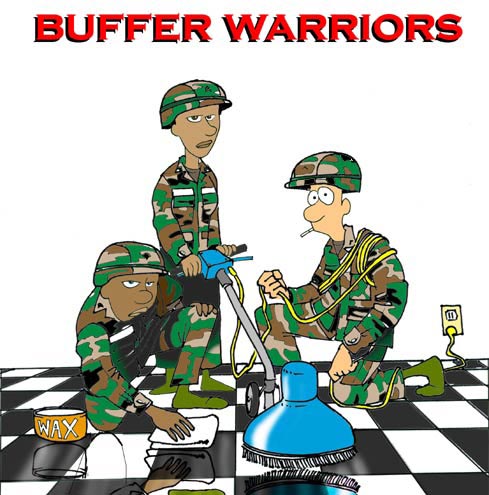
Want Pvt Murphy in your pocket?
 Return to U.S. Army Airborne Equipment Shop
Return to U.S. Army Airborne Equipment Shop
FEEDBACK!
Andy MacDougall agrees that we need to immerse ourselves in combat training not garrison BS:
"A few thoughts have come to my mind recently regarding a favorite topic of mine; training, more specifically infantry training since that of the other arms can mostly be taught either by drill alone or in a classroom and thus are easily and quickly trained by comparison. Also members of all the other arms should be able to fight as infantrymen if they are threatened to be over run or are needed as expedient replacements. So infantry training is something of a consuming passion of mine. Recently I have heard something that has had increasing meaning for me and coalesced many ideas swirling around in my mind for a wile. Col. Dale Dye, a former marine officer and now Hollywood military consultant and actor, in speaking of how he trained the actors in the recent movie 'The Great Raid' said something to the effect that he simply toke them out in the field for two weeks and immersed them in the experience of being an infantrymen. After watching TGR and remembering that he also was the principle military consultant for both 'Saving Private Ryan' and 'Band of Brothers', both of which impressed me by their technical accuracy, I found this pithy statement ringing through my mind for a long time. I have also felt the best kind of 'combat training' would be a field exercise of a duration of perhaps two weeks or so without any outside distractions and which attempts to simulate all the conditions of real warfare as much as reasonable safety will allow. This FTX would be structured as a succession of small, short individual- through platoon-skills building exercises within the context of a larger battalion-sized exercise of inter-platoon and inter-arm cooperation. I always imaged this as an annual event that would be the highlight of the troop's training. Instead Col. Dye's quote got me thinking that the best sort of training involving a whole way of thinking, like being a Soldier or learning a language, is to 'immerse' them in it by requiring them to 'live it' during there period of training with minimal to no distractions. Rather than have training take place within a barracks schedule in which only a fraction of the time is spend training and only a fraction of that in the environment in which they will actual use it, the field, due to the time and expense of moving there and back in the course of a day, why not condense it and spend ALL your time during training in the field? And if you spend all your time training in the field but you still need to spend some time back in 'civilization', which will have to be as long as in 'the field' if it is to count for anything, and if this barracks-less training environment is so effective that you can seemingly make better Soldiers (at least on screen) in two weeks than you can in twelve in a barracks-setting BCT/IET then why not have all your unit's Soldiers be reservists? Since military know-how, at least that based on experience, is rapidly perishable the current Reserve/Guard main training period of two weeks a year would seem insufficient. Instead I propose eliminating the one-weekend-a-month in favor of two-weeks-a-quarter, each two week period being spend entirely in field training. The precise training curriculum would be based on the commander's assessment of those areas either lacking in his troops or based upon what he perceives or is told is the likely mission he may soon be mobilized for. Two benefits of a reserve system is cheapness, so long as it doesn't come at the expense of effectiveness, compared to regular forces and less peacetime-army bureaucratic pettiness including barracks bullshitting."
Mark Ash reveals why Intolerable being on active-duty today in Army/Mc where lower ranks are forced to stay on base/post...some advocate returning to open squad bays....Mark writes about an open squad bay advocate:
"They were good for Colonels. They still are. In one of his emails to me he tried to impress me on how much of a "prison camp" our bases on Okinawa are and how those "abusive deployments" is what is dragging the USMC down. I tried to explain to him that, from the prospective of a E-3 and blow, they weren't much more of a "prison camp" then CONUS bases. I told him the only real difference was that SNCOs and Officers have some of their precious privileges, the essentials to RHIP, taken away, which really didn't bother me. He replied that we needed to put troops back in squad bays because they were cheap and that E-3s and below couldn't live out in town for any reason because they are all young kids that can't take care of themselves because they have only lived with mommy and daddy, they would just get drunk all the time, get DUIs making their way on base, would show up late or not at all. His excuse to why they were treated badly in squad bays was because their were "too many officers with too little to do" and didn't really understand that his same BS mentality on the problem is exactly why they are baby-sat in barracks, even if their were fewer officers with more important things to do.
But the argument that really, really pissed me off the most (other then saying a E-1 is somehow even less capable of taking care of themselves then a college freshmen) was that their wasn't the money to do it. Their is plenty of money. First their is the $4.5 Billion spent on Base Housing every year. Second, and more importantly, their is the money that is already set aside for housing costs for EVERY active duty military person. In 2000 my unit handed out papers telling us each on our "total" pay. Mine was slightly over $22000 for the previous fiscal year. I felt cheated because I was making $1385 (or less) a month. Slightly over $400 dollars a month was for housing, which was "deferred" as I lived in the barracks. Their was a further $200 dollars for COMRATS. Now me and a friend could have paid for a decent two-bedroom place out in Twenty-nine Palms for $800 and lived fairly well. Divide the base housing budget by everyone on active duty and add half that money in and even an E-3 could live fairly well most places in CONUS. But you can understand how pissed off me and some of my friends were when we were informed that we were "paying" (in a manner of speaking) $400 a month for half of our cinder block prison cell."
Fantastic truths, Mark!
I agree with you. Treating lower ranking enlisteds like shit by constant babysitting on post is the "From Here To Eternity" crap we all hate. IMHO we should go to the BATTLEBOX system and everyone lives off post and commutes there each day arriving IN A GO-TO-WAR CONDITION. They have war gear and weapons with them ideally. For base/post security a REAL QRF is maintained on rotational duty. Soldiers with a life off-post might understand LIFE so they don't go overseas and start killing "ragheads".
Let's not long for the "good ole days" that were not very good.
We need BETTER DAYS with BETTER IDEAS.
The facts are the military brass are lying racketeers. They are taking YOUR PAY away to pay for cinder block prison cells to hold lower ranking enlisteds inside so they can fuck with you constantly and never have you leave the base/post so THEY can feel safe you will not get into legal trouble and MAKE THEM look bad. Meanwhile, the daily grind of building/lawn care and harassment BS gets no let up because YOU LIVE ON POST 24/7/365 with no let up. Its easy to see why Soldiers when they get time off drive thousands of miles to get home to be with some people who love them and are not beingh assholes to them, then they are driving back to post/base tired from sleep deprivation losing control of their cars and dying needlessly.
THE PROBLEM IS:
its intolerable being on active-duty today in Army/Mc.
This is what needs to be fixed as outlined by a no-BS BATTLEBOX system where we ditch all these BUILDINGS that plague us. We also need to tell anti-war Democrats NO! to more base housing construction PORK and tell them to buy us BATTLEBOX mobile TACTICAL housing that has usefulness in war.
Mike